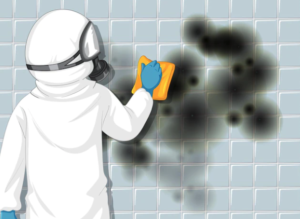Removing Molds from Home with Children it’s not just important; it’s essential!
Molds from Home can harm both human health and the structural integrity of buildings.
- The severity of the harm caused by mold depends on several factors, including the type of mold,
- the amount of mold present,
- and the length of time a person is exposed to the mold.
Molds from Home exposure can cause a range of symptoms, including
- allergic reactions such as sneezing, runny nose, red eyes, and skin rash,
- fever
- difficulty breathing
- People with existing respiratory conditions, such as asthma or emphysema, may be more susceptible to the effects of mold.
- Long-term mold exposure can also cause more serious health problems, such as neurological symptoms and immune system dysfunction.
Not all molds are created equal
Some can produce harmful chemicals called mycotoxins, which can cause serious health problems if ingested or inhaled.
In terms of building structures, mold can cause damage to walls, ceilings, carpets, and other surfaces and lead to odors and musty smells. When mold grows on surfaces, it can cause discoloration, staining, and warping, weakening the strength of the material on which it grows.
If you have a mold problem in your home or office, it’s essential to address it as soon as possible. A qualified professional should be consulted to determine the mold’s cause and develop a plan for removing it. It may require removing and replacing the affected building materials and treating the area to prevent mold growth.
In general, it’s a good idea to keep an eye out for mold and promptly address any mold problems to minimize potential health and structural risks.
In Our Own Homes
Homes with children can be particularly vulnerable to mold problems, as children are often more susceptible to the effects of mold than adults.
- Their immune systems are not yet fully developed
- May have difficulty breathing
- Have a higher risk of developing respiratory infections when exposed to mold.
Additionally, children
- may spend more time indoors, where they are more likely to be exposed to mold and more likely to come into contact with moldy surfaces or inhale mold spores.
What you need to know!
Be aware of the signs of mold growth in a home and promptly address any mold problems.
- Musty odors
- Visible mold growth
- Symptoms of mold exposure in children include coughing, sneezing, or difficulty breathing.
If you suspect, have a professional inspect and assess the situation.
Prevention is still better than Cure!
To prevent mold growth in the first place, it’s essential to
- Keep the home adequately ventilated
- Address any water leaks or moisture issues promptly
- Keep the indoor humidity low by using a dehumidifier or air conditioner. Additionally, regularly cleaning and maintaining the HVAC systems can prevent the accumulation of mold spores in the air ducts.
Also, educating children about the importance of keeping a clean and dry environment, especially in the bathroom and kitchen. Teach them about good hygiene habits and report any signs of mold or moisture to the adults.
Overall, keeping a close eye on potential mold issues and addressing them promptly is especially important in homes with children to keep everyone safe and healthy.
There are several reasons why it’s essential to consult a professional when dealing with a mold problem in your home or office.
- A professional mold inspector will have the knowledge, experience, and equipment to accurately identify and assess the mold problem’s extent.
This may include using specialized tools, such as
- moisture meters and infrared cameras to detect hidden mold growth or high moisture areas.
- The inspector will also be able to identify the type of mold present, which is essential for determining the appropriate course of action
- will be able to develop a plan for removing the mold tailored to the case’s specific circumstances
- This may involve eliminating and replacing affected building materials and treating the area to prevent further mold growth.
- Advise the best way to contain the mold, so it does not spread to other home or office areas.
IMPORTANT: Some mold types are more toxic than others; not all professionals are able and need a specific certification. A professional with the appropriate training and certifications will know how to safely and effectively remove these more toxic mold types.
Another important aspect is that professionals will have the necessary equipment to protect themselves and to contain the area where the mold is; that way, the exposure of the problem will be reduced to a minimum, and mold spores won’t spread to the rest of the house.
In addition, professionals will also ensure the proper disposal of contaminated materials, which is essential to prevent further contamination.
A professional mold inspector can help ensure that the mold problem is identified, assessed, and addressed most effectively and safely as possible.




